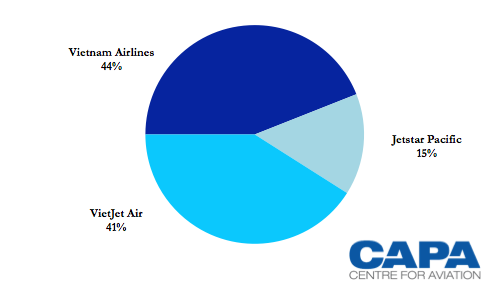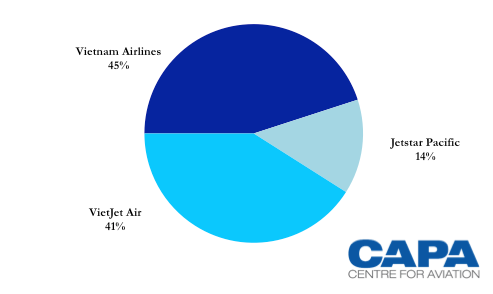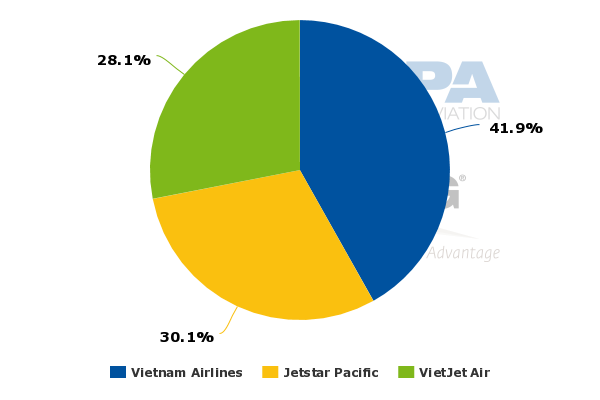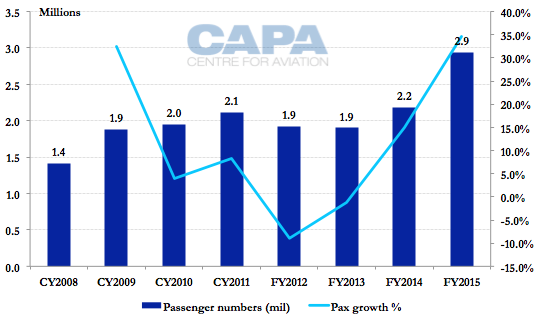Vietnam Airlines clarifies its dual brand strategy and accelerates Jetstar Pacific's expansion
Jetstar Pacific is accelerating fleet and network expansion as the Vietnamese LCC looks to make up for lost ground after being overtaken by its younger and more ambitious rival VietJet Air. The LCC languished, and was consistently unprofitable for the first seven years as the Qantas partnership slowly evolved, but it is now on track to post its first annual profit since adopting the Jetstar Pacific brand in 2008.
Jetstar Pacific resumed expansion in 2014, ending a prolonged period of flat or negative growth. Over the past two years it has more than doubled its fleet and domestic network while launching international services.
Shareholders Qantas and Vietnam Airlines have committed to nearly triple the joint venture's fleet over the next five years to up to 30 aircraft. Vietnam Airlines took over the majority stake from another government entity in early 2012, but has only recently begun to implement a clear dual brand strategy using Jetstar Pacific to compete against VietJet at the fast-growing bottom end of the Vietnamese market.
Jetstar Pacific was highly unprofitable over the first several years
Qantas initially acquired a 27% share in Pacific Airlines in 2007, which at the time was a small full service airline operating a fleet of five 737-400s. The airline adopted the Jetstar Pacific brand in 2008 as it transitioned to the low cost model, becoming Vietnam's first LCC.
But Jetstar Pacific had a challenging initial six years, racking up VND1.744 trillion (USD91 million) in operating losses and VND2.564 trillion (USD134 million) in net losses from CY2008 through CY2013. Revenues over the six years totalled VND13.185 trillion (USD689 million), equating to an average operating margin of negative 13%.
Jetstar Pacific pursued virtually no growth during the initial six years, operating a fleet of only five or six aircraft for the entire period. Annual passenger traffic was stalled at about the two million mark from 2009 to 2013.
In addition to lacking scale, Jetstar Pacific had a mixed fleet of A320s and 737-400s from late 2008 to early 2013, resulting in inefficiencies. Relations between Qantas and the initial majority shareholder, Vietnam's State Capital Investment Corporation (SCIC), were often less than cordial.
An obvious low point came in late 2009 and early 2010 when two Qantas executives on secondment in Vietnam to manage Jetstar Pacific were investigated as part of a probe into fuel hedging losses. The two executives were never charged but were prevented from leaving Vietnam for over six months.
Vietnam Airlines was slow to respond to VietJet
Vietnam Airlines took over the majority stake from SCIC in early 2012, while Qantas increased its stake to 30%. At the time it seemed Jetstar Pacific would quickly embark on a new more ambitious phase, particularly as rival VietJet had just launched at the end of 2011, providing new competition for Vietnam Airlines in the domestic market, but Vietnam Airlines initially remained hesitant to fully embrace a dual brand strategy.
See related reports:
- VietJet overtakes Jetstar Pacific as largest Vietnamese low-cost carrier
- VietJet to pursue more rapid expansion in 2013; Jetstar Pacific needs to respond - fast
Jetstar Pacific passenger traffic remained flat at about two million in CY2012 and CY2013. The airline remained highly unprofitable, despite the transition to an all A320 fleet at the beginning of 2013. It ended 2013 with a fleet of only five A320s - the same number of aircraft it had when it rebranded in 2008 - and a network of eight domestic destinations.
Jetstar Pacific finally began pursuing expansion in early 2014, after the delivery of its sixth A320, adding two domestic destinations in 2014 and its first three international destinations - Macau, Bangkok and Singapore.
See related reports:
- Vietnam Airlines subsidiary Jetstar Pacific begins to pursue faster expansion, starting with Macau
- VietJet Air and Jetstar Pacific plan more international expansion in 2015
Jetstar Pacific adds six domestic destinations and four international routes in 2015
The pace of expansion has accelerated further in 2015. Jetstar Pacific has launched six domestic destinations in 2015, including Dong Hoi and Thanh Hoa in February, Tuy Hoa in March, Chu Lai in May, Da Lat in June and Pleiku in October.
Hong Kong was also launched in 2015, becoming Jetstar Pacific's fourth regular international destination along with Bangkok, Macau and Singapore. The airline currently operates 28 weekly flights to these four destinations.
Macau is Jetstar Pacific's largest international destination, with two daily flights from Da Nang (launched in Mar-2014) and two weekly flights from both Hai Phong (launched Aug-2015) and Ho Chi Minh (launched Sep-2015). However, these are mainly sold as charters, with agents block booking nearly the entire flight, leaving only a few seats for sale on the Jetstar website.
Jetstar Pacific competes against VietJet to Bangkok and Singapore, and has begun serving mainland China with charters. VietJet currently operates 47 weekly international flights to five destinations - Bangkok, Seoul, Singapore, Taipei and Yangon - and also has charters to several destinations in China.
Bangkok, Hong Kong and Singapore are pure scheduled destinations where Jetstar Pacific has been able to leverage the Jetstar brand as they were already served by other Jetstar affiliates.
Jetstar Pacific currently operates one daily flight on Ho Chi Minh-Singapore (launched Oct-2014), five weekly flights on Ho Chi Minh-Bangkok (launched Dec-2014), five weekly flights on Hanoi-Bangkok (launched Mar-2015) and three weekly flights on Hanoi-Hong Kong (launched Sep-2015).
See related reports:
- Jetstar Pacific battle with VietJet Air intensifies as Bangkok and Singapore routes are launched
- Jetstar Pacific & VietJet Air pursue more rapid international expansion with Singapore & Seoul
- VietJet starts to exploit huge potential of Vietnam's international low-cost airline market
Jetstar Pacific now competes with VietJet on 13 domestic routes from Ho Chi Minh
Jetstar Pacific is keen to develop its international network further, particularly where it can leverage the Jetstar Group sales, marketing and distribution. But over the last year the domestic expansion has been a more significant strategic development for the LCC and its majority shareholder Vietnam Airlines.
With the six domestic destinations added so far in 2015, Jetstar Pacific now has as many domestic destinations as rival VietJet - 16. They currently have 15 destinations in common, compared with only 10 at the beginning of 2015, and one unique destination each. The unique Jetstar Pacific destination is Tuy Hoa (served from Ho Chi Minh) while the unique VietJet destination is Can Tho (served from Hanoi).
From Ho Chi Minh, Vietnam's largest city, Jetstar Pacific and VietJet now compete on 13 routes. Both LCCs also now have only one unique domestic route each - Tuy Hoa for Jetstar Pacific and Da Lat for VietJet.
All 13 common routes are shared with Vietnam Airlines. Vietnam Airlines also serves Ho Chi Minh-Da Lat, but does not operate Ho Chi Minh-Tuy Hoa as it currently only serves Tuy Hoa from Hanoi.
Jetstar Pacific domestic destinations from Ho Chi Minh ranked by weekly capacity: 2-Nov-2015 to 8-Nov-2015
| Rank | Airport |
Return Frequencies |
Return Frequencies |
Return frequencies |
|
|---|---|---|---|---|---|
| 1 | HAN | Hanoi Noi Bai Airport | 48 | 146 | 138 |
| 2 | DAD | Da Nang Airport | 22 | 83 | 77 |
| 3 | PQC | Phu Quoc International Airport | 21 | 28 | 42 |
| 4 | VII | Vinh City Airport | 11 | 28 | 14 |
| 5 | HPH | Hai Phong Cat Bi Airport | 10 | 40 | 21 |
| 6 | THD | Thanh Hoa Airport | 10 | 14 | 7 |
| 7 | CXR | Nha Trang Cam Ranh Airport | 8 | 26 | 27 |
| 8 | VCL | Chu Lai International Airport | 7 | 7 | 7 |
| 9 | TBB | Tuy Hoa Airport | 7 | 0 | 0 |
| 10 | HUI | Hue Phu Bai Airport | 7 | 7 | 28 |
| 11 | PXU | Pleiku Airport | 7 | 7 | 7 |
| 12 | UIH | Qui Nhon Phu Cat Airport | 7 | 7 | 14 |
| 13 | BMV | Buon Ma Thuot Airport | 5 | 7 | 21 |
| 14 | VDH | Dong Hoi Airport | 5 | 7 | 4 |
Jetstar Pacific expansion to enable Vietnam Airlines to stop losing market share
Vietnam Airlines has clearly decided that to compete effectively in Vietnam's fast growing domestic network it now needs Jetstar Pacific. As CAPA has previously highlighted, domestic capacity in Vietnam has more than doubled since VietJet's late 2011 launch, with VietJet accounting for about 75% of the additional seats. VietJet has quickly been able to secure a 40% share of Vietnam's domestic market, and capture almost all of the growth.
See related report: VietJet Air continues domestic expansion in Vietnam as its IPO approaches
Vietnam Airlines is now better positioned to take a larger share of the growth. Winning back market share is probably not a realistic scenario as VietJet continues to expand, but by offering a Jetstar Pacific option in 13 of the 14 routes shared with VietJet from Vietnam's commercial centre the flag carrier is able to compete more successfully in the fast growing bottom end of the Ho Chi Minh market. One year ago, on several of these routes, the flag carrier was relying entirely on its original full service brand to compete against VietJet.
Jetstar Pacific still does not have more capacity than VietJet on any of these 13 routes. But combined, Jetstar Pacific and Vietnam Airlines have more capacity than VietJet on almost all the routes.
Jetstar Pacific currently has slightly more than 60,000 weekly domestic seats in Ho Chi Minh, compared with over 160,000 for VietJet. Virtually all of this capacity is on competing routes, as Jetstar Pacific has only 2,520 return seats on the exclusive Ho Chi Minh-Tuy Hoa route while VietJet has the same amount of capacity on Ho Chi Minh-Da Lat.
Ho Chi Minh domestic capacity share (% of seats) by carrier: 2-Nov-2015 to 8-Nov-2015
While Jetstar Pacific could add capacity as the overall market grows, it is likely to remain the third largest player across the overlapping routes. It is more important for Vietnam Airlines to remain the overall market leader in Ho Chi Minh (when including both brands) than to try to match the LCC capacity.
It is also very unlikely Jetstar Pacific will retake VietJet as the largest LCC in the overall Vietnamese market. Even with the recently accelerated fleet expansion plan from Jetstar Pacific, VietJet expects to have more than twice as many aircraft as Jetstar Pacific at the end of 2020.
VietJet currently has slightly over 220,000 domestic seats in Vietnam compared to about 75,000 for Jetstar Pacific, according to CAPA and OAG data. Vietnam Airlines has slightly over 240,000 domestic seats, giving it about a 45% share or 59% when including Jetstar Pacific.
Nevertheless, by expanding Jetstar Pacific the Vietnam Airlines Group would be positioned to retain its market leading status. Without a bigger LCC brand the Vietnam Airlines Group risks being overtaken by VietJet Air.
Vietnam domestic capacity share (% of seats) by carrier: 2-Nov-2015 to 8-Nov-2015
Jetstar Pacific still has a relatively small operation at Hanoi and Da Nang
Although Jetstar Pacific is now serving all the main domestic routes from Ho Chi Minh, there is an opportunity to expand its network from Hanoi and Da Nang.
At the capital Hanoi, Jetstar Pacific currently operates only three domestic routes (Da Lat, Da Nang and Hanoi) compared to eight for VietJet, and 14 for Vietnam Airlines. VietJet is launching a ninth domestic route from Hanoi on 18-Nov-2015, when it commences four weekly flights to Chu Lai.
From Vietnam's third largest city Da Nang, Jetstar Pacific currently only serves Hanoi and Ho Chi Minh. VietJet has four routes from Da Nang and is looking at opening more, while Vietnam Airlines has eight routes.
Vietnam Airlines serves the smaller monopoly routes from Da Nang with ATR 72 turboprops. Although the flag carrier currently has a domestic network of 21 destinations, five more than VietJet or Jetstar Pacific, most of its monopoly airports are served with turboprops, and cannot currently accommodate A320s.
Jetstar Pacific keen to launch more point to point routes
However, Jetstar Pacific's biggest opportunities appear to be on new point to point routes, bypassing Vietnam's three main cities. Jetstar Pacific already has five such routes compared to only one for VietJet, which links the mountain resort town of Da Lat with the northern Vietnamese city of Vinh.
Four of Jetstar Pacific's point to point routes are at Buon Ma Thuot, a small city in the central highland of Vietnam with a population of 340,000 (2009). Jetstar Pacific initially experimented by opening a thrice weekly service in Mar-2013 from Buon Ma Thuot to Vinh. At the same time it also launched services from Ho Chi Minh to Buon Ma Thuot.
Buon Ma Thuot-Vinh has obviously been successful, as Jetstar Pacific still serves the route and has added another three routes from the city, which is known as Vietnam's coffee capital. Thrice weekly services to Hai Phong and Than Hoa were launched in Feb-2015, while two weekly flights to Chu Lai were launched in late Oct-2015.
Buon Ma Thuot, Chu Lai and Tuy Hoy are the only Vietnamese airports that now have more capacity from Jetstar Pacific than VietJet. Buon Ma Thuot is by far the largest of these airports - it is currently in the number 10 spot among all Vietnamese airports based on seat capacity.
Buon Ma Thuot capacity share (% of seats) by carrier: 2-Nov-2015 to 8-Nov-2015
Jetstar Pacific also launched a thrice weekly service in late Oct-2015 between Da Lat and the central Vietnamese secondary city of Hue. As is the case with its four point to point routes from Buon Ma Thuot, there are no other airlines offering non-stop flights between Da Lat and Hue.
As the middle class population in Vietnam's secondary cities increases there will be opportunities to open more point to point domestic routes.
LCCs are ideal for such routes as there is limited business or premium demand for such markets, but there is significant leisure demand, particularly if the fares are low enough to entice passengers that are now travelling by bus between regional cities.
Vietnam Airlines dual brand strategy advances with Jetstar Pacific codeshare
Vietnam Airlines is not hesitating to use Jetstar Pacific on new secondary point to point routes, as there is no risk of cannibalising the main brand. The two airlines began codesharing on May-2015, enabling Vietnam Airlines to offer its passengers seats on Jetstar Pacific's unique domestic and international routes.
The codeshare also covers overlapping routes, giving passengers the opportunity to fly in one direction on Jetstar Pacific in markets where Vietnam Airlines may not offer a flight at the same time of day. With the codeshare Vietnam Airlines is also able to offer in some cases improved domestic connections to its international flights.
After years of confining Jetstar Pacific to a limited number of flights on a limited number of routes, the LCC is now part of a much clearer and more promising dual brand strategy.
Most importantly Jetstar Pacific is now profitable again.
The airline's two shareholders have stated that Jetstar Pacific was in the black through the first three quarters of 2015, putting it on a path to post its first ever annual profit.
Jetstar Pacific reportedly generated a profit of over VND80 billion (USD4 million) in the first nine months of 2015. (Note: While Vietnam Airlines disclosed financial figures for Jetstar Pacific for 2008 through 2013 as part its 2014 IPO filing, it has not yet reported any financial figures for 2014. The shareholders have acknowledged Jetstar Pacific remained in the red in 2014.)
Jetstar Pacific has high load factor - but yields remain challenging
The airline is also growing for the first time in six years. For the year ending 30-Jun-2015, Qantas reported that Jetstar Pacific passenger numbers increased by 35% to 2.9 million.
Jetstar Pacific annual passenger numbers and year over year growth (%): 2008 to 2015
ASKs were up 30% in the year ending 30-Jun-2015, outstripping a 26% increase in RPKs; Jetstar Pacific's load factor fell 2.5ppt to 87%.
Jetstar Pacific's load factor has been consistently around the 90% mark for the last several years, but domestic load factors have traditionally been high in Vietnam, while yields are generally very low.
Jetstar Pacific annual RPKs, ASKs and load factor: 2008 to 2015
Yields remain low, particularly as both Vietnamese LCCs aggressively add capacity, but profitability has obviously improved as fuel prices have dropped. Jetstar Pacific also has gained scale as it has expanded its fleet and network, and it has been reducing costs, in part by pursuing synergies with its two shareholders.
VietJet already has sufficient scale and an extremely low cost base, which has enabled it to be profitable from an early stage with a load factor consistently above 90%.
Jetstar Pacific to grow fleet to 30 aircraft by 2020
VietJet currently has 23 A320s and two A321s under its operator's certificate while Jetstar Pacific has nine A320s and two A321s, according to the CAPA Fleet Database. This excludes wet-leased aircraft, however. VietJet has traditionally supplemented its fleet with one or two wet-leased A320s while Jetstar Pacific also at times has wet leased A321s from parent Vietnam Airlines.
In early 2015 Jetstar Pacific also began dry leasing two A321s from Vietnam Airlines. These aircraft have been repainted in Jetstar Pacific colours and are considered part of the Jetstar Pacific fleet, but remain under Vietnam Airlines registration.
Jetstar Pacific's shareholders recently unveiled a new five year plan to expand its fleet to up to 30 aircraft by the end of 2020. The Jetstar Group has said its Vietnamese affiliate will be able to access its order book for A320s/A320neos, as well as other synergies.
Over the last few years Jetstar Pacific has been obtaining its A320s independently. Even with the Jetstar Group having excess A320s, due to the delays and eventual failure at its proposed new affiliate in Hong Kong, Jetstar Pacific opted to take A320s from leasing companies, and A321s from Vietnam Airlines.
The Vietnam Airlines A321s are far from ideal as they are in two class 184 seat configuration although Jetstar Pacific does not have a business class product. VietJet's A321s are in single class configuration with up to 230 seats, giving it a significant unit cost advantage on thicker routes.
Clearer dual brand strategy emerges for Jetstar Pacific but some questions linger
While Vietnam Airlines seems committed to expanding the joint venture, it is unclear whether it will be willing to start using Jetstar's aircraft.
More clear is the flag carrier's desire to leverage Jetstar in other areas, and use Qantas' expertise and assistance in implementing its new two brand strategy. There is hardly a better teacher in this area than Qantas, which was a pioneer with its dual brand strategy.
However, over the long term Vietnam Airlines may relook at its options for Jetstar Pacific, particularly as it succeeds in bringing in a new strategic investor at the group level. The new investor could apply pressure for Vietnam Airlines to take full control of the LCC subsidiary. Vietnam's relationship with Qantas has never been entirely smooth, and Vietnam has never been totally comfortable with having one of its airlines adopt a foreign brand - even though the "neutral" Jetstar brand is more suitable for pan-Asian operations.
At least for now Vietnam Airlines and Qantas seem to be on the same page, perhaps pushed together by the rapid rise of VietJet. Vietnam Airlines simply cannot afford to continue to remain idle as VietJet continues to expand rapidly.
The only sensible solution is to accelerate expansion at Jetstar Pacific.
Now is clearly the time for Vietnam Airlines to make a move and unveil a more ambitious plan for its previously floundering LCC subsidiary. As VietJet seeks an initial public offering, which was initially planned for 2015 but has been delayed to 2016, Vietnam Airlines is sending a clear message that it intends to fight back.




